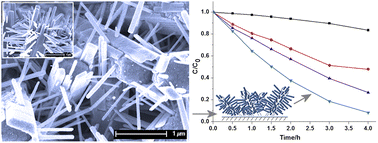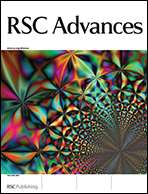Microstructure, growth process and enhanced photocatalytic activity of immobilized hierarchical ZnO nanostructures†
Abstract
The hierarchical ZnO nanostructures, branched nanorods, were prepared through a multi-step growth method on glass substrates without any capping agents. The process includes magnetron sputtering deposition of ZnO seed particles and hydrothermal growth of ZnO nanorods. The morphology, growth process and microstructure were characterized using scanning electron microscopy (SEM), high resolution transmission electron microscopy (HRTEM) and X-ray diffraction (XRD). The hierarchical structure consists of large primal nanorods as the trunks and much smaller secondary nanorods as the branches. Both the trunks and branches are single crystal grown along the [0001] direction. The ZnO seed particles which experienced Ostwald-ripening are essential for the growth of branched nanostructures. Raman scattering, photoluminescence (PL) emission and UV-Vis absorption were applied to measure the defects and optical properties. The hierarchical ZnO nanostructures exhibited the enhanced photocatalytic performance in degradation of Rhodamine B (RhB) under UV light, which can be attribute to the increased surface area, improved light harvesting, active surfaces, dense branch network and large amount of defects.


 Please wait while we load your content...
Please wait while we load your content...